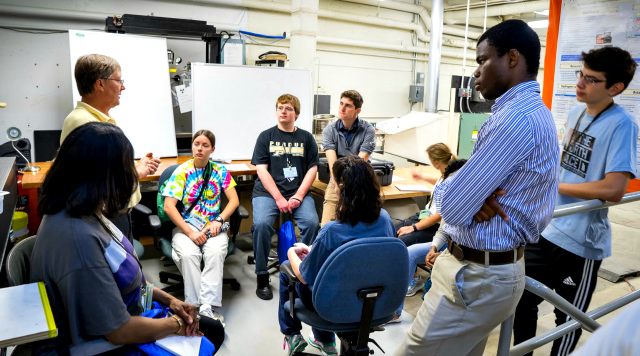Adam Fluck, August 14, 2016
If the planet?s population continues to grow as predicted, an inevitable energy crisis would result.
Pankaj Sharma, managing director of the Duke Energy Academy at Purdue University, is quick to share some staggering statistics: There are currently 7.6 billion people living on Earth and by 2050, that number is projected to be 9 billion. The population now consumes 15 terawatts of power, but by 2050, that amount is expected to double.
?The challenge is how we will transition to a new economy in the 21st century where we rely on more renewable methods into the energy mix,? notes Sharma.
This question is what drives those involved with the Duke Energy Academy to inspire young minds capable to tackling the problem. The Academy pairs high school students and teachers to create a more secure energy future.
Thinking creatively, becoming a better teammate and overall problem solving are encouraged with a strong emphasis on the STEM disciplines: science, technology, engineering and mathematics.
Since its inception in 2012, the annual weeklong program has impacted more than 350 students and teachers from over 120 schools and 20 different states.
?Getting young people involved is very important,? explains Sharma.

In addition to lectures from university professors and industry leaders, students have a number of ways to learn and engage as they study topics ranging from the distribution of electricity to solar/wind energy and even nuclear energy. There are also a number of hands-on activities, field trips and research projects.
For the students, the program is free of charge.
Tolu Omotoso is a PhD candidate in civil engineering at Purdue who has been involved in the program since it started. Now a project coordinator for the academy, he keeps track of the overall operations and helps it grow.
?Working on the program has exposed me to the essentials of project management and I have been able to develop leadership skills, which I believe will be valuable as I transition into the industry after my doctorate degree,? says Omotoso.
Alexander Lai has also benefitted from the academy. He?s steadily gotten more involved – even fulfilling a counselor-like role – since he was accepted into the program in 2014.
?It?s no exaggeration to say that this program helped shape my future,? Lai wrote in Johns Hopkins? Imagine Magazine. ?My experience at the Energy Academy helped me decide to become an engineer. I was on the fence between medicine and engineering, but this program inspired me to be part of a field that is already changing the world.?
Sharma wants to expand the program. A major proposal to the National Science Foundation is in the works that could net as much as $1.2 million in funding. The money would allow an expansion of the program?s reach regionally and nationally, perhaps even internationally.
Another challenge for Sharma is to create a more diversified workforce for the energy industry and academics.
Sharma feels none of it would be possible without the support of Purdue. The school, along with the program?s partners, enhance its impact through a collaborative effort.
?When you look at energy as a topic, it?s very interdisciplinary,? explains Sharma. ?There is science, physics, chemistry, biology and mathematics, among others, in addition to economic, environmental, policy, and social aspects. We have close to 180 faculty members who are doing research related to energy.?
Plans are already in the works for the next academy, which will take place June 18-24, 2017. High school students and secondary teachers interested in applying need to do so by January 15, 2017 on the Energy Academy?s website.
While Sharma is confident the program has made a strong impact locally on those who have participated — over 93 percent of students have indicated that they would enter a STEM-related field in college and pursue energy careers — he?s most interested to see their work down the road.
?When the students first come to us they are in high school and by the time they graduate college, they are well on their way to becoming energy leaders,? notes Sharma. ?It?s hard to know what kind of impact they?ll have 10, 15 or 20 years from now, but we see a clear indication they are ready to contribute to the energy security issues that we face as a nation and STEM disciplines in general.?
By Adam Fluck







